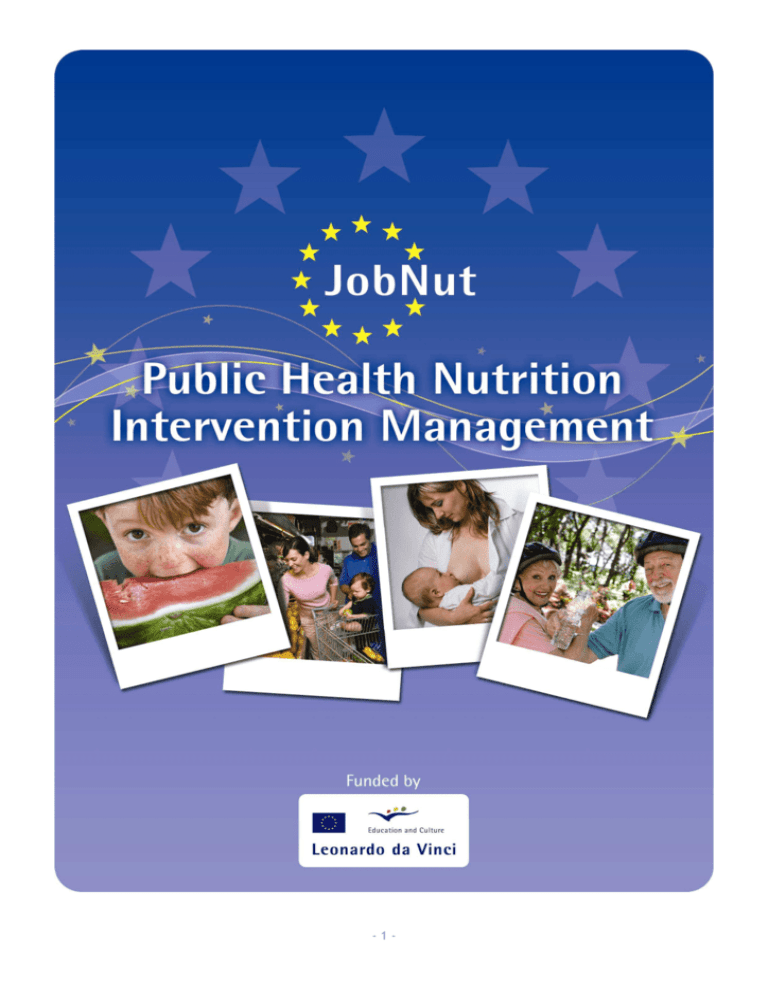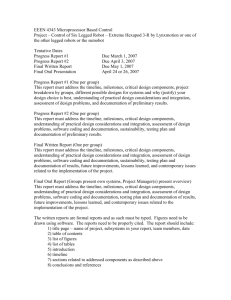Unit 11 - Implementation Planning 090128
advertisement

-1- PERMISSION FOR USE AND COPYING Intellectual property rights for this material rests with the Authors. Permission to use and copy this resource is freely granted for educational purposes. These Units are designed to be delivered intact as complete Units, however there may be situations where use of part of the Unit is warranted in educational contexts. If you are reproducing in part only, please credit: Hughes R, Black C, Kennedy NP. Public Health Nutrition Intervention Management: Implementation and evaluation planning. JobNut Project, Trinity College Dublin. 2008. ADDITIONAL COPIES The complete suite of 18 Public Health Nutrition Workforce Development units developed by the JobNut Project and the related Educator’s Guide are available for downloading at the following website: http://www.medicine.tcd.ie/nutrition-dietetics/jobnut/ DISCLAIMER This workforce development unit has been produced as part of the JobNut Project, supported by the Leonardo Da Vinci Program, Education & Culture, European Commission. The opinions and conclusions expressed in this paper are those of the author(s) and no official endorsement by the funder is intended or should be inferred. ACKNOWLEDGEMENTS Funding to support the JobNut Project was provided by the Leonardo Da Vinci Program, Education & Culture, European Commission. This Unit has been developed by Professor Roger Hughes, Christina Black and Dr Nick Kennedy of the Unit of Nutrition and Dietetic Studies, School of Medicine, Trinity College Dublin. Implementation and Evaluation Planning -2- Action Unit 11 – Implementation and Evaluation Planning Learning Objectives On completion of this unit, students should be able to: 1. Describe the importance of implementation planning and evaluation planning in public health nutrition intervention management. 2. Identify and apply a process for planning the implementation of strategies in a public health nutrition intervention. 3. Deconstruct strategies into work packages that clearly define the work and resources required for implementation 4. Describe and employ techniques for developing work schedules (timelines) in public health nutrition intervention management. 5. Describe and employ techniques for developing and designating budgets in public health nutrition intervention management. Intelligence Unit Readings • Thurston, W. and Potvin, L. Evaluability Assessment: a tool for incorporating evaluation in social change programmes. Evaluation. 2003. 9: 453-469. • Bowen, A. Healthy mother, healthy baby: program logic model and evaluability assessment. 2004. Community-University Institute for Social Research, University of Saskatchewan: Saskatoon. • The Health Communication Unit. The ten steps to evaluating a health promotion program. 2007. The Health Communication Unit, University of Toronto: Toronto. Implementation and Evaluation Planning -3- Contents: Page No. Planning for Intervention Implementation 5 Developing Work Package Plans 8 Work Scheduling – Developing a Gantt Chart 9 Developing Intervention Budgets 14 Establishing an Intervention Management System 17 Evaluation Planning 17 Levels of Evaluation 19 Developing Evaluation Indicators and Plans 20 Summary of key points 23 Additional Resources and Readings 24 References 24 From: Hughes R, Margetts B. Public Health Nutrition: A Practitioners Handbook. Blackwell Publishing, 2009. Implementation and Evaluation Planning -4- Implementation and Evaluation Planning Preamble Planning interventions (Units 9 & 10) focus on questions of “what to do” but do not adequately detail the “how, when, by who and with what” type questions important for strategy implementation. These later questions are the focus of intervention planning covered in this unit. Intervention planning is a form of “reverse engineering” in the sense that we start with a broad strategy structure and work to break it down into its components so that we can identify what resources (time, money, expertise etc) are required to fabricate the strategy in a way that ensures that it actually works. In this process the implementation planning process develops a “blue-print “for action. These blue-prints should be adequately transparent and detailed to enable someone else to use as a guide to strategy implementation. Implementation planning starts with the strategy mix described in earlier Action phase steps and systematically works through a process of : 1. Deconstructing strategies into activities (or work packages) 2. Considering the time and resources required to do this work 3. Scheduling the sequence of work, and 4. Assigning responsibilities for work completion. Detailed work packages are also key risk management tools. Evaluation planning should occur in parallel with implementation planning to ensure the two processes are linked (evaluation after all involves considerable work). This also encourages stakeholders to view evaluation as a crucial, inseparable component of the intervention that is worthwhile of their participation. Evaluation assesses whether intervention objectives have been met, determines if the methods used were appropriate and well-organised, and feeds these findings back into planning process to improve PHN practice (adding to the intelligence base). The various levels of evaluation include formative, process, impact and outcome. Indicators are used as criteria against which to determine achievement of intervention objectives and strategies. Planning for Intervention Implementation Before implementing or putting the intervention into action, an implementation plan needs to be developed to identify and structure when, where and with what resources each task of the intervention are to be undertaken. Whilst the intervention plan describes how the population nutrition problem for a particular target group will be addressed (“what type questions”), the implementation plan details the specific tasks of the intervention identifying who is responsible for each task, the resources required and the timeline within which the task should be completed (The how, who, when and with what type questions). Developing a detailed implementation plan documents the role of each intervention player and helps to ensure the intervention is delivered on time, within budget and will achieve the desired result (1). Implementation and Evaluation Planning -5- An implementation plan is a core project management tool (a blue-print for action) and provides a hierarchical breakdown of the work to be done for the intervention. Using the intervention logic model, an implementation plan considers each intervention output and illustrates in sequence, from general to specific, all the activities and tasks required to produce that output (2). An implementation plan also defines the scope of work of the intervention - whatever is not in the implementation plan is outside the realm of activities for the intervention. An intervention plan is developed to: • • • • • • • Define what needs to be done in the intervention and the order in which tasks should be completed Determine resource allocation and define tasks for delegation and the skill set required Confirm a common understanding of the scope of work among the funding agency, project management committee, senior management and the project team Assist with identification of milestones Assist with preparation of an intervention timeline (Gantt chart) Assist with budget estimation Assist with identification of intervention risks by indicating areas of uncertainty Source: (2) An implementation plan can be created using any techniques of listing and grouping project activities and tasks. Intervention logic models (see Unit 10) can be used to isolate strategies in order to reverse engineer. This essentially involves deconstructing strategies into activities and tasks (i.e. work packages) that need to be completed to enable strategy implementation (2). Example After a process of analysis (as outlined in Units 1-8), prioritisation and selection of strategies leads to the selection of a group-based food skills education strategy. The strategy is designed to help achieve the following objective: • To enhance self efficacy# related to the preparation of healthy meals amongst single adult males # Self efficacy is the belief in ones ability to successfully change behaviour- and is proposed by Social Learning theory to be a major determinant of successful behaviour change Implementation and Evaluation Planning -6- Table 1 below provides an example of a process to identify activities and tasks related to each strategy. Generally an intervention will require more than one page to complete this process. In brief, the process to complete the table follows: • Write each strategy in a row, using as many rows and pages as necessary • Break each output into sequential units of work; activities. Activities are all the things that need to be completed to produce the output, and should be in the order they need to be started. • Write each activity into a separate cell in the relevant output column. • Break each activity into sequential smaller units of work called tasks. Write these in the same cell as the relevant activity. • Review the list to confirm the activities and tasks are appropriately grouped and classified. You may find a task is adequately complex it should be labelled another activity. • Check to ensure completion of each set of tasks will result in achievement of the activity, and that completion of each group of activities will result in achievement of the output above. Move activities and tasks around as necessary. • Finally, give each item on the list a unique identifier to use as a reference. This completed table can then be used to inform other aspects of the intervention plan such as determining resource allocation (intervention budget), developing a timeline (Gantt chart) and identifying key intervention milestones. Table 1. Intervention outputs, activities and tasks – strategy “reverse engineering” tool Strategy Education group – food skills and knowledge Activity 2.1 Identify nutrition expertise & develop session curriculum 2.2 Identify resources and equipment for sessions 2.3 Etc etc Tasks 2.1.1 2.1.2 2.1.3 2.1.4 2.1.5 2.1.6 2.1.7 2.1.8 2.2.1 2.2.2 2.2.3 2.2.4 Search local health networks for nutritionist Approach nutritionist/s for assistance Liaise time/resource commitment Development of appropriate curriculum Consultation on draft curriculum Pilot curriculum Refine curriculum Design & print session material Identify budget available for sessions Search and cost local venues/ caterers Seek quotes/ availability from venues/ caterers Consult intervention team re results and confirm session dates + catering 2.2.5 Determine appropriate venue and caterer etc 2.2.6 Book venue and catering etc 2.3.1 Etc etc Adapted from: (2) Implementation and Evaluation Planning -7- Exercise 1. Draw up a table, like Table 1, to identify the activities and tasks for each of the outputs listed in the logic model you developed in Unit 10 for your identified scenario. Be sure to use as many columns and rows as required and follow each of the steps outlined above. Workshop/tutorial option: Complete the exercise in small groups followed by a whole-class debriefing CPD option: Conduct the above exercise in the context of your current work role and an identified nutrition problem in the community or population you are working with. Developing Work Package Plans After identifying the activities and tasks required for achieving each output, work package plans for each output can be detailed. A work package plan should be developed for each strategy. In reality, many activities service the implementation needs of a number of strategies. The details and development of a work package should be undertaken by the intervention player responsible for implementing the activities and tasks. Developing work packages for intervention outputs allows transparency in intervention activities and identification of key milestones for each work package. Detailed work packages descriptions (blueprints) are also key risk management tools, assisting to reduce disruption if staff-turnover or partner departure occurs as the details of the tasks to be undertaken are available and can be implemented by another individual or team if necessary. Work packages can be illustrated in various forms and usually include specific reference to the sequence and duration of activities. One format for developing detailed work packages is the Gantt chart. Gantt charts are commonly used in project management which shows all the activities (and tasks if desired) of the work packages in sequence showing estimated time of completion on a horizontal car chart. Details about this useful tool are outlined in the following section ‘developing a Gantt chart’. Table 2 below shows another format for developing a work package. The table lists the key milestones and major activities for a work package, who is responsible, the scheduled start and finish dates, and the predecessor (if appropriate). In this format milestones are shown in bold and indicated by a blank scheduled start date. These milestone scheduled finish dates are determined when planning and developing the work package and are used to monitor the progress of the intervention. Activities in the predecessor column must be completed prior to the named activity commencing. Implementation and Evaluation Planning -8- Table 2. Work package schedule – example format Work package ID WP 2 2.1 2.1.4 2.1.5 2.1.6 2.2 2.2.8 2.3 2.3.9 Description Who Scheduled start Scheduled finish Indentify nutrition expertise + develop session curriculum Develop, consult and pilot curriculum Project manager 05 Feb 2009 18 Feb 2009 Nutritionist 20 Feb 2009 30 March 2009 Identify and book venue +catering Arrange necessary IT equipment etc Advertising and recruiting for sessions Final RSVP for sessions Project officer Project officer Project team Project team Nutritionist/ project team Project management committee 20 Feb 2009 05 March 2009 11 April 2009 2.2 23 April 2009 2.2 2.4 Educational sessions commenced 2.5 Evaluation results reported to project management committee 05 March 2009 05 March 2009 05 March 2009 30 April 2009 Predecessor 2.1 23 April 2009 30 June 2009 2.1, 2.2, 2.3 30 July 2009 2.4 Adapted from: (4) Work Scheduling- Developing a Gantt chart A Gantt chart is a horizontal bar chart that shows intervention activities and tasks in sequential order with the bars representing the time estimates to complete them. The chart geographically depicts the time relationship of activities, tasks, milestones and resources in an intervention. It is a flexible document that should be regularly updated through the life of the intervention (5). A Gantt chart usually includes: • The major activities and tasks of the project • The project milestones • The interdependencies between phases/ activities/ tasks • A timeline • The person and responsible for each item • The resources required for each item (5). A completed Gantt chart can be used for day-to-day management, planning and reporting. It can also be useful to present to senior management and clarify planning estimates, work requirements and timelines. Implementation and Evaluation Planning -9- A Gantt chart is developed to: • • • • • • • Assist in determining how long activities and tasks will take Identifying the critical path – that is the shortest possible path from the first activity to the last (useful for determining minimum time to complete the project) Use as a baseline for reporting Assist in determining how long the project will take, including in analysing the effect on the overall timeframe of activities going overtime Assist with identification of project risks by showing areas of uncertainty Assist with the management of risk by showing the effect on the project timeline of a risk occurring Confirm a common understanding of the project timeline among the funding agency, project management committee, senior management and project team. Source: (5) In brief, the process to complete a Gantt chart follows: • List the work/ work packages of the intervention – list all intervention outputs in a separate cell down the left hand column, under each output insert a new row and list all the activities to be done to produce the output. • Identify resources – In the Resource Name column list the resources required for delivery of the activity. • Identify who is responsible – In the Resource Name column, or create a new column entitled “Who” where the person/team responsible for delivering the activity can be recorded. • Estimate timeframes – Use the remaining columns to create a timeline for the project. Estimate the timeframe required for each activity and fill in the cells in each activity row from estimate start date to estimated completion date. Order the activities sequentially and in the output row fill in the cells from the beginning of the first activity to the last – to show the length of time for the output to be completed. • Identify milestones – Milestones are significant events that act as progress markers for an intervention and are usually linked to the completion of a key project activity or task or may be linked to funding payments. Show milestones by adding a marker on the timeline such as a black diamond or certain cell colour and the finish date. Add a description of the milestone. Figure 1 an example of a Gantt chart used in intervention management. The Gantt chart shows intervention outputs and activities listed against a timeline. Project tasks, the sub-activities that need to be completed to achieve each activity can also be listed if required. This table can be used for a single work package or all project outputs. In some instances, the complete intervention timeline and the individual work packages (detailing the tasks) are all developed to provide a comprehensive implementation plan. The timeline of the Gantt chart can be in days, weeks or months according to the intervention. Table 3 is based on a simple spreadsheet (5). Implementation and Evaluation Planning - 10 - Figure 1. Example Gantt chart 1 Implementation and Evaluation Planning - 11 - Practice Note When estimating your timeline, be realistic and pragmatic about the predicted time it will take to complete activities and tasks. Remember to take into account the level of input for example a 2 day task would take 4 days to be completed by a project worker working part-time at 50%. The more detailed your “reverse engineering” of strategies into activities and tasks, the more likely you will have better insights into the time and other resources required to implement the strategy. One of the painful side effects of poor implementation planning is under-estimating resource requirements, leaving you short of budget but still having to implement as promised. Exercise 2. Considering your selected scenario and the outputs, activity and task table developed in Exercise 1 draft a timeline for your intervention on a Gantt chart. You may also choose develop separate sheets for each work package of your intervention in addition to the overall timeline. Use Microsoft Excel or a simple Word table to complete this exercise (as in the following example). Workshop/tutorial option: Complete the exercise in small groups followed by a whole-class debriefing CPD option: Conduct the above exercise in the context of your current work role and an identified nutrition problem in the community or population you are working with. Implementation and Evaluation Planning - 12 - Strategy/Activity Accountable Officer/s Duration Jan Feb Implementation and Evaluation Planning - 13 - Mar April May Months June July Aug Sept Oct Nov Dec Developing Intervention Budgets Budgeting is the determination of costs associated with the defined activities of the intervention. Budgeting information generally reflects funding for the life of the project however it can also be broken into intervention stages, work packages or financial years (4). As PHN interventions are often funded by one-off grants it is vitally important to design and cost the intervention properly as most funding agencies and philanthropic foundations do not see their role as on-going funders of core intervention activities (6). This emphasises the key importance of strategy sustainability implicit in capacity-building approaches to public health nutrition practice. Developing an intervention budget involves calculating the cost of the activities of the intervention. Table 3 provides an example format for estimating the intervention expenditure. This costing of intervention implementation is a critical component of many of the economic evaluation methods outlined in a later unit in the intervention bi-cycle (economic evaluation). A costing table can be developed for each strategy and then collapsed into a total intervention budget table. Some • • • • example cost titles include: Personnel / Staff – wages, salaries, recruitment, benefits, payroll tax, on-costs and overheads Catering/ venue hire – catering and venue hire for events, can include equipment rental etc Travel – All travel, accommodation and meal costs Design / publishing / printing – printing, publishing or copying brochures, invitations, reports, books, reprints, website designs and costs • Phone / postal – Teleconference, mobile, mailing costs • Contingency – an additional 5% of the total budget to cover things that occur unexpectedly. Be aware however that funders are wary of a miscellaneous column in the budget as this signals that the applicant has not thoroughly thought through the actual budget requirements and may have forgotten items of expenditure (6). • Income – remember to include any income expected from intervention activities or funding milestones. Implementation and Evaluation Planning - 14 - Table 3. Intervention costing table – example Personnel/ Staff Catering/ Venue Hire Travel Design/ Publishing Phone/ Postal Contingency TOTAL Activity 1.1 Activity 1.2 Activity 1.3 Activity 2.1 Activity 2.2 etc Source: (6) Table 4. Budget Summary – example Item Item description In-kind cost Existing sources Additional cost Required from the project funds Total in-kind contribution Total being requested Staff Catering/ Venue Hire Travel Design/ Publishing Phone/ Postal Other costs TOTAL Implementation and Evaluation Planning - 15 - Total cost A costing table should include both direct and indirect costs. Direct costs cover the resources that are actually expended on the project activities. Indirect costs are ‘in-kind’ expenses the partnering organisations are going to contribute to support the intervention. Indirect or in-kind expenses can include overheads, staff time, some phone costs etc. Documenting in-kind costs is important to include for organisational finance purposed and because funding agencies generally to see the organisation they are funding are also contributing to the intervention. Table 6 provides an example of an intervention budget summary that clearly shows in-kind costs, additional costs required and the total cost of the intervention against each cost title. A brief description of the items and calculation methodology should also be included, such as estimated hours work required by hourly rate for different project workers. A budget summary table such as Table 6 is a useful way of submitting the intervention budget in a funding submission. Estimating intervention costs requires some educated guess work and should involve: • Calling for quotes • Having staff members estimate the amount of time an activity will require • Asking finance staff to provide standard formulas for estimating on-costs and overheads • Using standard government and consultancy rates to calculate staff/ consultancy costs • Comparing cost notes with a colleague who has completed a similar intervention. Practice Note Being able to accurately predict the resources needed to implement an intervention and justify this resource allocation is an important part of the grantsmanship process. A submission that fails to explain and justify how each item of funding (e.g. Salaries, travel costs, equipment) relate to the activities outlined in the plan is likely to be considered too expensive and will generally not be funded. Remember to show ‘in kind’ costs, funding agencies like to see the organisation they are funding is also contributing to the intervention. Accurate budgeting depends on a clear understanding of the work required to implement the intervention. Using the work packages developed that breakdown the intervention into activities and tasks serves as a sound basis for indentifying and predicting the various interventions costs. Remember, it is important to be competitive when tendering for an intervention grant and considering how much your competitors are going to quote. However, do not follow competitors into making a loss – an intervention cannot be successful without adequate resources. Implementation and Evaluation Planning - 16 - Exercise 3. Considering your selected scenario and your intervention activities, replicate the budget summary table to complete a budget estimate for your intervention. Allocate cost titles appropriate to your intervention. You should make your budget estimates as accurate as possible seeking quotes and actual salary recommendations provided by professional organisations or government authorities. When estimating on-costs, assume them to be 25% of salary / wages. Workshop/tutorial option: Complete the exercise in small groups followed by a whole-class debriefing CPD option: Conduct the above exercise in the context of your current work role and an identified intervention. Establishing an Intervention Management System Intervention management can be significantly aided through the development of an implementation plan. The management structure of an intervention identifies the specific players, their responsibilities, accountabilities and the interaction between them for the life of the intervention. Ultimate responsibility and accountability for the intervention must be clearly defined and accepted at an appropriately high-level within the partnering organisations (3). Implementation plans can aid intervention management through the documentation detailed intervention activities with time-orientated indicators. Intervention players can be kept accountable for their contribution and expected performance of the intervention activities, actual expenditure against predicted costs can be assessed, and achievement of intervention milestones can be monitored. Documenting predicted activity for the intervention and subsequent monitoring of intervention activity, enables project management to take if action milestones, budgets or outcomes of the intervention are not being met. Without an implementation plan good intervention management is not possible because detailed documentation for accountability is not available. Governance in PHN intervention management is covered in more detail in Unit 12 Implementation and Monitoring. Remember that active involvement of key stakeholders in intervention implementation is a key capacity building strategy. Evaluation Planning Intervention evaluation is the systematic collection of data to enable critical appraisal of an intervention’s activities and outcomes resulting in sensible conclusions and useful proposals to improve intervention efficiency, effectiveness or adequacy (7, 8). In simple terms, evaluation assesses whether the intervention objectives have been met, determines if the methods used were appropriate and well-organised, and feeds these findings back into planning process to improve the intervention. Implementation and Evaluation Planning - 17 - In addition to facilitating intervention improvement evaluation also produces knowledge that can enrich PHN and health promotion practice through contributing to the published and grey literature (adding to the intelligence-base). Sharing evaluation findings helps to inform future interventions, informing others of the effectiveness of different strategies and enabling practitioners to make informed decisions when planning interventions. Evaluation can also help prevent reinvention and the recurrence of errors (1). Evaluation starts at the planning stages of an intervention and continues throughout the life of the intervention. Implementation planning and the selection evaluation methods to determine intervention effectiveness should occur simultaneously (8). One of the flaws noted in health promotion practice has been the inability to build an evaluation plan into the intervention planning phase (9). It is important to plan evaluation strategies in parallel with implementation planning to ensure the two processes are linked and inform each other, and to assure stakeholders view evaluation as a crucial, inseparable component of the intervention that is worthwhile of their participation, increasing the internal validity of the evaluation (10). Reasons for evaluation: • • • • • • Effectiveness – assess what has been achieved and whether the intervention had its intended effects Efficiency – measure intervention impact and whether the intervention was worthwhile Economic impact – assess cost-effectiveness and whether the time, money and resources were well-spent and justified Efficacy – measure the appropriateness and relevance of the intervention to the target group Intelligence - contribute to the body of intelligence to inform future planning and theory building Accountability - justify intervention resource use and allocation to others Adapted from: (1) Implementation and Evaluation Planning - 18 - Levels of Evaluation There are several different levels of evaluation in health promotion and PHN interventions: 1. Formative evaluation – data collected prior to implementation of the intervention that is used to inform the intervention design and assess capacity for action. Formative evaluation is the systematic incorporation of feedback about the planned intervention activities. This type of evaluation helps to indentify and rectify potential inadequacies of the intervention design and can be used to validate the problem, determinant and capacity analyses. Feedback about the intervention design may be obtained by conducting a pilot study or inviting critique from colleagues or experts in the field (11). 2. Process – assesses the intervention strategies and capacity building strategies. Process evaluation takes place during intervention implementation, considers participants perceptions and reaction to intervention strategies and is commonly employed to assess the appropriateness and equity of a health promotion intervention. Process evaluation involves consideration of coverage and process such as participation rates and participant demographics. Data is commonly gathered from participants, trusted colleagues or self-assessment through qualitative methods – interviews, diaries, observations, reflections – and the findings can be dismissed as unrepresentative. Process evaluation however provides insight into how interventions are interpreted and responded to by different groups of people and whether the strategies are reaching the intended target group (1). 3. Impact (summative short-term) – measures whether the intervention objectives have been met. Impact evaluation considers the changes that have occurred since the intervention began and how participants or target group think the intervention will affect their future behaviour. Impact evaluation commonly involves one of three methods: post-test only, pre-test/ post-test or pre-test/ post-test with control group. Pre-test/ post-test design is useful to determine if a change in knowledge, attitude or behaviour has occurred, while the use of a control group helps to avoid the danger of over estimating the intervention affect by attributing all knowledge/ attitude/ behaviour change to the intervention. Results for impact evaluation are often expressed numerically from quantitative methods that increase credibility of the findings (11). 4. Outcome (summative long-term) – measures whether the intervention goal has been achieved Outcome evaluation involves assessment of the longer-term effects of the intervention which is usually more complex, more difficult and more costly than the other forms of evaluation. Outcome evaluation is important because it measures sustainment of changes overtime and is commonly conducted sometime after (several years) the intervention has officially finished. Similar to impact evaluation, outcome evaluation usually involves one of the three quantitative measurement methods to produce numerical, more credible results (1). 5. Economic – measures cost-effectiveness of the intervention or intervention strategies Economic evaluation involves identifying, measuring and valuing both the inputs (costs) and outcomes (benefits) of the intervention. There are four distinct types of economic-evaluation: costminimisation, cost-effectiveness, cost-utility and cost-benefit. Implementation and Evaluation Planning - 19 - Figure 2 illustrates the relationship between Action statements and Evaluation levels. Evaluation and planning are inter-related and complementary. Figure 2. Relationship between Action Statements and Evaluation Relationship of goals and objectives to evaluation Problem reflected in Goal measured by Outcome evaluation Determinants reflected in Objective measured by Impact evaluation Strategies reflected in Strategy Activities measured by Process evaluation It is important to note that evaluation is not an exact science. There is no absolutely right or wrong way to evaluate your programs and there is no discrete formula that helps us in this process. Different people will have different opinions about what information is important. Key issues to consider in evaluation planning: • What is the key purpose of evaluation? • What resources are required and available? • What will be the focus of the evaluation? • What evaluation design will be used? • Who will be involved in the evaluation process? • Who will conduct the evaluation? • Who will interpret the evaluation data? • Who will have access to the result of the evaluation? Source: (11) Developing Evaluation Indicators and Plans Planning for evaluation involves consideration of the fundamental elements of evaluation: 1. Indentifying a criterion or standard of good performance (indicator) 2. Gathering the relevant data through observation and measurement (focus groups, interviews, survey questionnaires, or direct observation) too make an assessment Specifying the standard or criteria to be used to determine success is essential component of evaluation which holds the evaluation process to public scrutiny (12). Developing indicators is associated with intervention objectives and strategies. Indicators are specific measures that signify the point at which goals and objectives have been achieved and are used as the criteria in intervention evaluation (13). There can be more than one indicator linked to an objective or strategy and often these indicators are measures of parts of goals and objectives that cannot be directly measured. Implementation and Evaluation Planning - 20 - The development of evaluation indicators involves using the intervention logic model to re-examine the objectives and strategies. Each objective and strategy should have at least one clearly defined indicator of success. Impact indicators Objectives may be divided into long-term and shorter-term or objectives and sub-objectives. Longer term impact indicators are usually about attitude, knowledge, behaviour or policy change, while short-term impact indicators are the results measured as soon as the intervention is completed. The impact indicators that correspond with an objective should specify what information will be collected to determine whether the intervention has achieved its objectives. Long-term impact indicators do not necessarily contain the degree of change required or the directions if there are no set standards, or previous findings to base predictions about the amount of change. Short-term impact indicators include reported barriers and facilitators to change, lessons learned from working with the target group and participant perceptions/ knowledge of the intervention (13). Process indicators Intervention strategies or activities could be reviewed or revised every three or six months, annually or biannually, depending on how long they take to be implemented. Process indicators consider the course of action and usually measure reach, distribution level, appropriateness of the strategies, ideas for improvement, participant satisfaction and feedback etc (13). The process of developing a evaluation indicators and a plan should be consultative and involve participation from stakeholders and the target group. The process of intervention evaluation is further outlined in the readings by Thurston et al (2003) and The Health Communication Unit (2007), and is explained in detail in the following units of the PHN Intervention Management learning package. The following reading, an article by Bowen (2001) provides a useful overview of the development of a multi-strategy intervention to improve health status of mothers and babies in high risk vulnerable women in the Saskatoon region of Canada. This article (while covering an area broader than PHN) provides an illustration of consultative logic model development and its application in planning intervention and evaluation strategies. Practice Note Evaluation planning should be heavily dependent and integrated with determinant analysis and related logic modelling. Evaluation needs to answer the questions: • Has the intervention changed determinants? • By how much? • How and why? (or just as important questions, such as why not?) Implementation and Evaluation Planning - 21 - Intelligence Readings Thurston, W. and Potvin, L. Evaluability Assessment: a tool for incorporating evaluation in social change programmes. Evaluation. 2003. 9: 453-469. Bowen, A. Healthy mother Healthy baby: program logic model and evaluability assessment. 2004. Community-University institute for Social Research, University of Saskatchewan: Saskatoon. The Health Communication Unit. The ten steps to evaluating a health promotion program. 2007. The Health Communication Unit, University of Toronto: Toronto. Exercise 4. After reading the articles by Thurston et al (2003), Bowen (2004) and The Health Communication Unit (2007) consider your selected scenario and outline a methodology for developing an evaluation plan. Using you logic model developed in Unit 10, create evaluation indicators to guide your process, impact and outcome evaluation strategies. Workshop/tutorial option: Complete the exercise in small groups followed by a whole-class debriefing CPD option: Conduct the above exercise in the context of your current work role and an identified nutrition problem in the community or population you are working with. Assessment Considering your selected scenario and using your responses to Exercises 2 and 3 complete the timeline and budget sections of the intervention management template. Workshop/tutorial option: Complete the exercise in small groups followed by a whole-class debriefing CPD option: Conduct the above exercise in the context of your current work role and the community or population you are working with. Implementation and Evaluation Planning - 22 - Key Points • An implementation plan is a core project management tool and provides a hierarchical breakdown of the work to be done for the intervention. The intervention logic model is used to develop the implementation plan by indentifying each intervention output and illustrating in sequence, from general to specific, all the activities and tasks required to produce that output. • A Gantt chart is a horizontal bar chart that shows intervention activities and tasks in sequential order with the bars representing the time estimates to complete them. The chart geographically depicts the time relationship of activities, tasks, milestones and resources in an intervention. • Budgeting is the determination of costs associated with the defined activities of the intervention. Developing an intervention budget involves calculating the cost of the activities of the intervention. A costing table may be developed for each work package or a single overall budget may be more appropriate. • Implementation plans can aid intervention management through the documentation detailed intervention activities with time-orientated indicators. Intervention players can be kept accountable for their contribution and expected performance of the intervention activities, actual expenditure against predicted costs can be assessed, and achievement of intervention milestones can be monitored. • Evaluation assesses whether intervention objectives have been met, determines if the methods used were appropriate and well-organised, and feeds these findings back into planning process to improve PHN practice. The various levels of evaluation include formative, process, impact and outcome. Indicators are used as criteria against which to determine achievement of intervention objectives and strategies. Additional Resources and Readings Evaluating health promotion programs • Van Marris, B. and King, B. Evaluating Health Promotion Programs. Version 3.6. 2007. The Health Communication Unit: Toronto. • Ryan, D., Mannix McNamara, P. and Deasy, C. Evaluation. In Health Promotion in Ireland: principles, practice and research. 2006. Gill and Macmillan: Dublin. p. 133-138. • Naidoo, J. and Willis, J. Health Promotion - Foundations for Practice. 2nd Ed. 2000, Harcourt Publishers Limited, London. p Implementation and Evaluation Planning - 23 - References nd 1. Naidoo, J. and Willis, J. Health Promotion - Foundations for Practice. 2 Limited, London. 2. Department of Premier and Cabinet. Project Management Fact Sheet: Developing a Work Breakdown Structure. In Tasmanian Government Project Management Framework. 2008. Tasmanian Government: Hobart. 3. Tasmanian Government. Governance. In Tasmanian Government Project Management Guidelines Version 6.0. 2005. Tasmanian Government: Hobart. 4. Department of Premier and Cabinet. Project Business Plan (small) - Template and Guide, version 2.1. In Tasmanian Government Project Management Framework. 2008. Tasmanian Government: Hobart. 5. Department of Premier and Cabinet. Project Management fact Sheet: Developing a Gantt Chart, version 1.1. In Tasmanian Government Project Management Framework. 2008. Tasmanian Government: Hobart. 6. Our Community/ Westpac Community Solutions for Community Groups. Project budgeting. 2001. Accessed on 15 October 2008 at http://www.ourcommunity.com.au/financial/financial_article.jsp?articleId=2204 7. World Health Organisation. Health programme evaluation: guiding principles. 1981. World Health Organisation: Geneva. 8. Oslen-Keller, L., Schaffer, M., Lia-Hoagberg, B. and Strohschein, S. Assessment, program planning, and evaluation in population-based public health practice. Public Health Management Practice. 2002. 8(5): 3043. 9. Hawe, P., Degeling, D. and Hall, J. Evaluating health promotion: a health worker's guide. 1990. MacLennan and Petty: Sydney. 10. Thurston, W. and Potvin, L. Evaluability assessment: a tool for incorporating evaluation in social change programmes. Evaluation. 2003. 9: 453-469. 11. Ryan, D., Mannix McNamara, P. and Deasy, C. Health Promotion in Ireland: principles, practice and research. 2006. Gill and Macmillan: Dublin. 12. O'Connor-Fleming, M-L. and Parker, K. Health Promotion: principles and practice in the Australian context. nd (2 Edition). 2001. Allen and Unwin: Crows Nest. 13. The Health Communication Unit. Introduction to Health Promotion Planning. 2001. The Health Communication Unit, University of Toronto: Toronto. Implementation and Evaluation Planning - 24 - Ed. 2000, Harcourt Publishers







